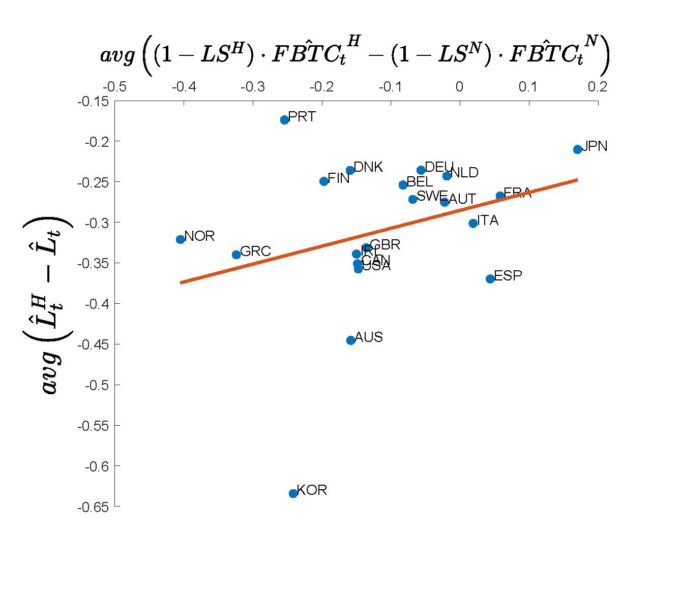Newsletter mensuelle sur la désindustrialisation : Factor-Bias Technological Change and Labour Reallocation
30 mai 2023

Dans le cadre d’un projet financé par Leverhulme Trust (projet RPG-2019-348), Olivier Cardi (Lancaster University Management School), Romain Restout (Université de Lorraine, BETA Nancy) et Benjamin Caswell (Lancaster University Management School) proposent une newsletter mensuelle sur la désindustrialisation.
Newsletter #8: “Factor-Bias Technological Change and Labour Reallocation”
In this Newsletter, we show that factor-biased technological change accelerates the deindustrialization trend in OECD countries over 1970-2017. Intuitively, because traded firms bias technological change toward capital, the demand of labor declines in traded industries which amplifies the shift of labor toward the non-traded sector, thus explaining the downward trend line in the scatter plot. Non-traded industries also bias technological change toward capital but only slightly on average although our estimates reveal a wide cross-country dispersion. To estimate factor-bias technological change series for both sectors for our sample of 20 OECD economies, we adapt the methodology developed by Caselli and Coleman (2006) by considering CES production function and the concept of technology frontier.
As highlighted in our previous newsletters, sector-bias productivity growth is the primary cause of labor reallocation towards the non-traded sector. When productivity grows faster in the traded sector, the cost of producing goods in the non-traded sector increases which leads non-exporting industries to charge higher prices to compensate for a higher marginal cost. Because the demand for non-traded goods is weakly elastic, the non-tradable content of expenditure increases (since consumption in non-traded goods declines very slightly). This draws labor away from the traded sector and towards the non-traded sector. Factor-neutral productivity growth which is biased towards the traded sector, remains the key driver of deindustrialization – accounting for more than half of the observed reallocation. We find that the addition of factor-bias technological change contributes almost 15 percent to the observed reallocation of labor in our representative OECD economy.
Indeed, so far, we have imposed Cobb-Douglas production functions which imply that firms use a fixed proportion of labor and capital. In contrast, in this Newsletter, we assume that the elasticity of substitution between capital and labor is smaller than one and thus inputs are gross complements, as evidence suggests for most of the countries and sectors. Therefore, an increase in labor-augmenting productivity raises the demand for capital. Probably due to the development of automation of tasks, robotization of production chains, outsourcing and offshoring, labor-augmenting productivity growth is concentrated in traded industries which accelerates deindustrialization in all OECD counties except two, i.e., France and Japan. For the latter countries, technological change is strongly biased toward capital in non-traded industries.
In the next Newsletter, we quantify the magnitude of skill biased technological change at a sectoral level and explore its potential role in shifting unskilled labor away from traded and towards non-traded industries.






